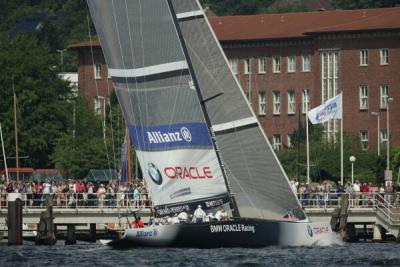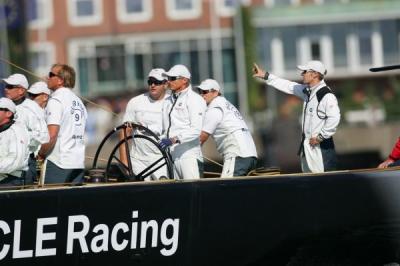Q&A: How Long is the Race Course? Feb 11, 00:05
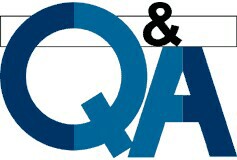 Our old friend Kimball Livingston of San Francisco, a veteran yachting and Cup journalist and longtime member of the venerable St Francis YC, emailed us today saying that the upcoming issue of SAIL Magazine (for which he writes) will have a primo special section on the America's Cup. We look forward to seeing it. In the meantime, Kim asked a question the answer to which may interest some of you....
Our old friend Kimball Livingston of San Francisco, a veteran yachting and Cup journalist and longtime member of the venerable St Francis YC, emailed us today saying that the upcoming issue of SAIL Magazine (for which he writes) will have a primo special section on the America's Cup. We look forward to seeing it. In the meantime, Kim asked a question the answer to which may interest some of you....Q: How long will the race course be during the Louis Vuitton Cup, and will it be the same for the AC Match?
A: The course length is variable between 8.6 and 12.6 nautical miles. The configuration is the same for the LVC and Match, and we expect the maximum length course normally to be used for the LVC Semis and Finals as well as the AC Match.
The LVC Notice of Race was published by Regatta Director Dyer Jones on New Year's Eve. Among many other things, it covers details of the race course that the Race Committee will use. The NOR for the AC 32 Match (between the ultimate Challenger and the Defender Alinghi) is out in draft form but has yet to be finalized. However, because of the draft and well-known TV time constraints, we know how the course for the Match will sort out as well. Overall:
+ LVC and AC Match courses will always be four-leg, windward-leewards, same as for all the Acts. The first and last legs are .3 nautical miles longer than legs two and three because the gate (which ends leg two) is set .3nm to windward of the start/finish line.
+ Overall the RC is aiming for a race to last about 90 minutes -- this to fit into a two-hour TV show including an intro, the pre-start, and a post-race show -- to hit that targe the RC will vary the length of the course according to wind strength.
+ For Round Robin 1 of the LVC, the courses will need to be shorter to have time to sail the scheduled two two races per day. Under the rules, in light air they could be as short as 8.6nm (a 2.3nm first leg). Probably more like 2.8nm on a normal Valencia 10-14 knot afternoon. Longer if its windier.
+ In RR2, the Semifinals and Finals of the LVC, when only one race per day is scheduled, you can expect the races to be longer than in RR1. The maximum length permitted under the NOR is 12.6nm (a 3.3nm first leg). The 12.6nm course will be the norm in the Match, hence we Challengers have asked the RC to try to use it as much as possible during the LVC Semis and Finals to get the Challengers practiced up for it -- the exceptions being if we have encounter several days of bad weather and, God forbid, have to go back to running two races a day to finish up the Semis or Finals on time, or on a light air day when there is only 7 knots or so of breeze).
By comparison, in Auckland we normally sailed three-lap courses of slightly more than 18 miles.
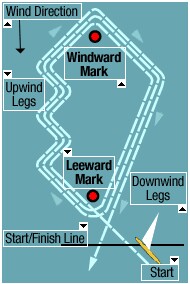
The three-lap race course used in 2003. For 2007, it's the same windward-leeward configuration but only two laps, and the leeward mark has been replaced by a "gate".
Q&A | by TFE
 Thanks for your many kind comments and emails after we posted
Thanks for your many kind comments and emails after we posted 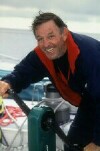 "There are one or two points in the answer to Marc's question that need clarifying and correcting. The Lawson History was published in a limited edition of 3,000 at Boston in 1902. Thomas's axe was that he had refused to join the New York Yacht Club, and that club could not countenance a boat owned outside its membership to compete for the right to defend, so Lawson's Independence was refused entry to the trials that were held in 1901. Ironically, the shape of Independence appeared to have an influence on Nat Herreshoff when he designed Reliance in 1903. Whereas Boudoin Crowninshield didn't produce the right engineering to make the great scow-form work, Herreshoff did.
"There are one or two points in the answer to Marc's question that need clarifying and correcting. The Lawson History was published in a limited edition of 3,000 at Boston in 1902. Thomas's axe was that he had refused to join the New York Yacht Club, and that club could not countenance a boat owned outside its membership to compete for the right to defend, so Lawson's Independence was refused entry to the trials that were held in 1901. Ironically, the shape of Independence appeared to have an influence on Nat Herreshoff when he designed Reliance in 1903. Whereas Boudoin Crowninshield didn't produce the right engineering to make the great scow-form work, Herreshoff did.